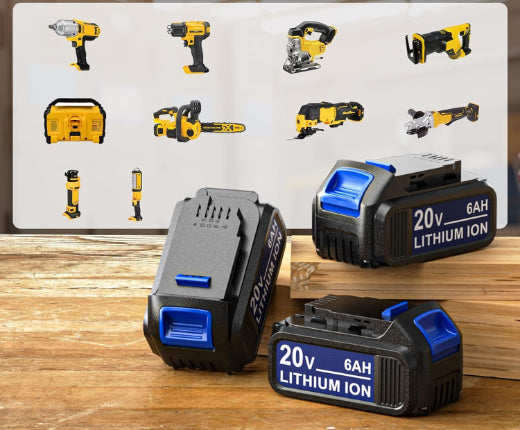
HIGHER Ah BATTERIES: DO THEY GIVE YOU MORE POWER OR JUST LONGER RUNTIME?
When you're shopping for cordless power tools or replacement batteries, one of the most common specs you’ll see is the amp-hour rating - 2.0Ah, 4.0Ah, 6.0Ah, and so on. But what does that actually mean for how your tool performs? It’s a common question: Does a higher Ah battery give you more raw power, or does it just let your tool run longer? Let’s clear that up once and for all.
What Does "Ah" Really Stand For
An ampere-hour (Ah) is a measure of how much electrical charge a battery can deliver over time. In simple terms, it tells you how long the battery can supply a consistent current before it needs to be recharged. For example, A 2.0Ah battery can theoretically deliver 2 amps of current for one hour. A 5.0Ah battery can deliver 5 amps of current for one hour - or 2.5 amps for two hours, and so on.
Does a Higher Ah Mean More Power
Not exactly. Power comes from a combination of voltage and current. The voltage (usually 18V or 20V in most cordless tools) stays the same between batteries in the same system. The Ah rating doesn’t increase the voltage - it just increases the amount of energy available.
With some tools - especially newer brushless models - a higher Ah battery can help sustain peak performance for longer under heavy loads. That means the tool is less likely to stall, bog down, or overheat. It’s not giving it more horsepower, but it’s helping the tool maintain its horsepower more consistently. In other words: Higher Ah = longer endurance, not more strength.
Why Choose a Higher Ah Battery? Three Key Advantages
- Longer runtime: You’ll get more done between charges, especially with high-drain tools like saws and grinders.
- Better performance under load: Some tools will run smoother or maintain torque better with a high-capacity battery.
- Fewer battery swaps: You’ll spend less time changing batteries and more time working.
But Bigger Isn’t Always Better
Before you rush to buy the biggest battery you can find, keep this in mind:
They’re heavier: A 12.0Ah battery can add serious weight to your drill or driver, making it more tiring to use for long periods.
They cost more: Larger batteries are significantly more expensive.
They take longer to charge: Unless you're using a fast charger, you might be waiting a while.
If you’re doing light-duty work - like driving screws or drilling into soft wood- a 2.0Ah or 3.0Ah battery might be all you need. On the other hand, if you're running a circular saw all day, a 6.0Ah or higher battery can be a game-changer.
A higher Ah battery gives you longer runtime and better endurance under heavy loads. It won’t necessarily make your tool more powerful in the traditional sense, but it can help the tool perform at its best for longer.
If you're a contractor, a serious DIYer, or just tired of your batteries dying mid-job, going for a higher Ah battery makes sense. But for casual or light-duty users, you may be better off sticking with something smaller, lighter, and more affordable.






